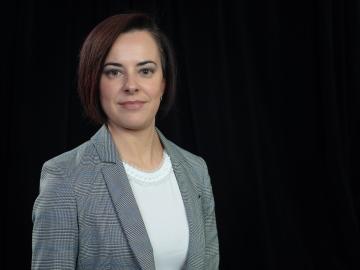
Filter News
Area of Research
- Advanced Manufacturing (5)
- Biological Systems (1)
- Biology and Environment (102)
- Biology and Soft Matter (4)
- Building Technologies (2)
- Chemical and Engineering Materials (3)
- Chemistry and Physics at Interfaces (7)
- Clean Energy (168)
- Climate and Environmental Systems (7)
- Computational Biology (1)
- Computational Chemistry (5)
- Computational Engineering (1)
- Computer Science (3)
- Data (1)
- Earth Sciences (1)
- Electricity and Smart Grid (1)
- Energy Frontier Research Centers (7)
- Fuel Cycle Science and Technology (2)
- Functional Materials for Energy (8)
- Fusion and Fission (33)
- Fusion Energy (7)
- Geographic Information Science and Technology (1)
- Isotopes (22)
- Materials (122)
- Materials for Computing (13)
- Materials Synthesis from Atoms to Systems (8)
- Materials Under Extremes (7)
- National Security (47)
- Neutron Data Analysis and Visualization (2)
- Neutron Science (73)
- Nuclear Science and Technology (27)
- Quantum Condensed Matter (3)
- Quantum information Science (4)
- Renewable Energy (2)
- Sensors and Controls (2)
- Supercomputing (155)
- Transportation Systems (4)
News Type
News Topics
- 3-D Printing/Advanced Manufacturing (43)
- Advanced Reactors (8)
- Artificial Intelligence (51)
- Big Data (30)
- Bioenergy (51)
- Biology (60)
- Biomedical (31)
- Biotechnology (12)
- Buildings (23)
- Chemical Sciences (27)
- Clean Water (15)
- Climate Change (52)
- Composites (8)
- Computer Science (89)
- Coronavirus (17)
- Critical Materials (5)
- Cybersecurity (14)
- Decarbonization (47)
- Education (2)
- Emergency (2)
- Energy Storage (30)
- Environment (105)
- Exascale Computing (31)
- Fossil Energy (4)
- Frontier (27)
- Fusion (31)
- Grid (26)
- High-Performance Computing (49)
- Hydropower (5)
- Isotopes (31)
- ITER (2)
- Machine Learning (23)
- Materials (46)
- Materials Science (49)
- Mathematics (7)
- Mercury (7)
- Microelectronics (3)
- Microscopy (20)
- Molten Salt (1)
- Nanotechnology (16)
- National Security (47)
- Net Zero (8)
- Neutron Science (53)
- Nuclear Energy (56)
- Partnerships (21)
- Physics (31)
- Polymers (8)
- Quantum Computing (23)
- Quantum Science (32)
- Renewable Energy (1)
- Security (12)
- Simulation (34)
- Software (1)
- Space Exploration (12)
- Statistics (1)
- Summit (33)
- Sustainable Energy (48)
- Transformational Challenge Reactor (3)
- Transportation (27)
Media Contacts

Mohamad Zineddin, a distinguished researcher in nuclear and radiological engineering, recently received the Roger Howsley Award for Excellence in Nuclear Security.
Researchers at ORNL recently demonstrated an automated drone-inspection technology at EPB of Chattanooga that will allow utilities to more quickly and easily check remote power lines for malfunctions, catching problems before outages occur.

Researchers at ORNL are using satellite images of homes under construction to address gaps in census data, especially in areas like Sub-Saharan Africa. By analyzing these images, they estimate dwelling sizes and population densities where traditional data is sparse. This method improves population estimates and supports national security by enhancing emergency response capabilities.

Alicia Manjón Sanz, a neutron scattering scientist, has been selected to represent ORNL at the 21st Annual Meeting of Science and Technology in Society forum later this year in Kyoto.

The Quantum Computing User Forum welcomed attendees for a dynamic event at ORNL. The annual user meeting brought the cohort together to highlight results and discuss common practices in the development of applications and software for quantum computing systems.

Jeremiah Sewell leads a team at ORNL, working on xenon-129 production for lung imaging. Reflecting on his career, Sewell views each opportunity as a "door" he steps through, leveraging over 25 years of experience in nuclear power and centrifuge operations to advance the facility’s mission.

Debjani Singh, a senior scientist at ORNL, leads the HydroSource project, which enhances hydropower research by making water data more accessible and useful. With a background in water resources, data science, and earth science, Singh applies innovative tools like AI to advance research. Her career, shaped by her early exposure to science in India, focuses on bridging research with practical applications.

A study found that beaches with manmade fortifications recover more slowly from hurricanes than natural beaches, losing more sand and vegetation. The researchers used satellite images and light detection and ranging data, or LIDAR, to measure elevation changes and vegetation coverage. Changes in elevation showed how much sand was depleted during the storm and how much sand returned throughout the following year.
The University of Tennessee at Chattanooga and the Department of Energy’s Oak Ridge National Laboratory are entering into a memorandum of understanding with the intent to collaborate in efforts to research, develop, deploy and evaluate technology and analytically based solutions to challenges in the area of quantum information science and engineering, including networking, sensing, and computing.

At ORNL, a group of scientists used neutron scattering techniques to investigate a relatively new functional material called a Weyl semimetal. These Weyl fermions move very quickly in a material and can carry electrical charge at room temperature. Scientists think that Weyl semimetals, if used in future electronics, could allow electricity to flow more efficiently and enable more energy-efficient computers and other electronic devices.


